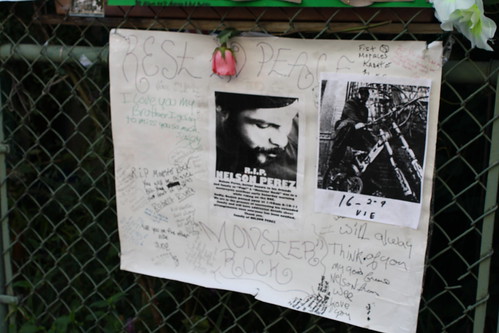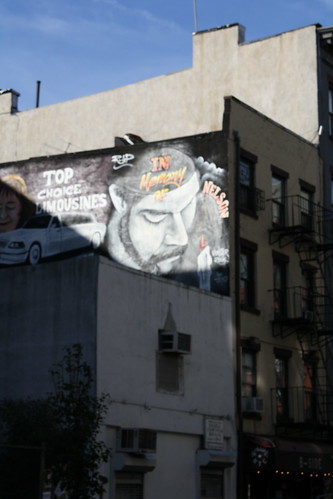 Carly Okyle Part of the memorial to Nelson Perez, an East Village resident who died on September 10.
Carly Okyle Part of the memorial to Nelson Perez, an East Village resident who died on September 10.In a recent photograph, Nelson Perez is sitting on a bicycle that he had built himself, looking cool and confident. Around the East Village, he was known as Monster Rock (or “Monstro”), as well as the Gentle Giant. Bicycles and motorcycles were his passion. It was a passion that would eventually kill him, and he knew it.
“He would say, ‘I’m gonna ride to die,’” said Sandra “Sin” Mercado, a friend of Mr. Perez’s who was with him on the early hours of Saturday, September 10, when the fatal accident took place.
They were heading from Fort Greene, Brooklyn to Bay Ridge, but the destination didn’t really matter — they were riding just to ride, on one of the last nights of summer. At about 12:45 a.m., Mr. Perez headed into a turn near Montague Street on the Brooklyn-Queens Expressway. He lost control of his motorcycle and clipped the guardrail before being thrown off the bike onto the lower level some 20 feet below. He was pronounced dead at Lutheran Medical Center just before 2 a.m., at the age of 48.
“All I saw was his motorcycle gliding across the highway,” said Ms. Mercado. “I saw his bike and asked, ‘What’s going on?’ and I went up to the railing and I saw him down there.”
Those who knew Mr. Perez best were saddened, but not entirely surprised. In the last conversation they had, Clifford La Fontaine gave him a prophetic warning: “Nelson had told me that he’d gotten the bike up to a speed that was not a legal speed – this enormous speed – and I said to him, ‘Nelson, at that speed you’re no longer a motorcyclist – you’re a statistic.’”
Mr. La Fontaine, 74, is a designer of exhibition spaces for museums whose studio on 13th Street was a haven for Mr. Perez during his childhood and a place of employment for him as an adult. The two worked together for 14 years. He remembers Mr. Perez as a responsible, dependable man who visited his mother daily and used his intimidating size – he was 5’11 with a powerful build – to protect whoever needed help.
“He had a great enthusiasm for doing things to the fullest and maybe a little step over,” he said. “His dreams were enormous, and his attitudes in life were enormous.”
Mr. Perez’s zeal extended to other interests, as well. He was a break-dancer, an athlete, a carpenter, and an artist. As a teenager, he was paid to dance at the legendary Cat Club on East 13th Street, which has now closed, and he once made a miniature rocking chair for Mr. La Fontaine’s wife out of silver gum wrappers. She had written him letters and sent him information on fitness and nutrition while he was in prison on drug-related charges – a time that Mr. Perez would later humorously refer to as his time in college.
Food and family were equally important, and his funeral and wake had both. Mr. Perez lay in the open casket in a black suit and red tie, representing his favorite colors. (Mr. Fontaine explained that internal fractures and hemorrhaging were the cause of death and that there had been no head trauma.) His long-time girlfriend, Peaches, brought red balloons which friends and family released to the heavens. Then a reception and benefit was held at Mug Lounge, and donations were collected to help pay for his 7-year-old daughter’s future expenses.
Mr. Perez is also survived by his mother, his sister, and Franki Acevedo, who he thought of as his stepdaughter. When she talked about him, Ms. Acevedo, 28, referred to him as Papi or as her father. “I have way more memories with Nelson than I have with either one of my biological parents,” she said. “That’s my Pops.”
Indeed many in the neighborhood counted on him. “My father never said no,” she said. “He always made time for people.”
Ms. Acevedo spent time with Mr. Perez the night before he died, while he worked on his bike. His recently acquired red Yamaha motorcycle made her nervous. “I was scared when he got that bike. All of us were looking at it like, ‘That bike is trouble,’” she said.
There might be some comfort, however, in the fact that Mr. Perez died as he had lived – doing what he loved.




